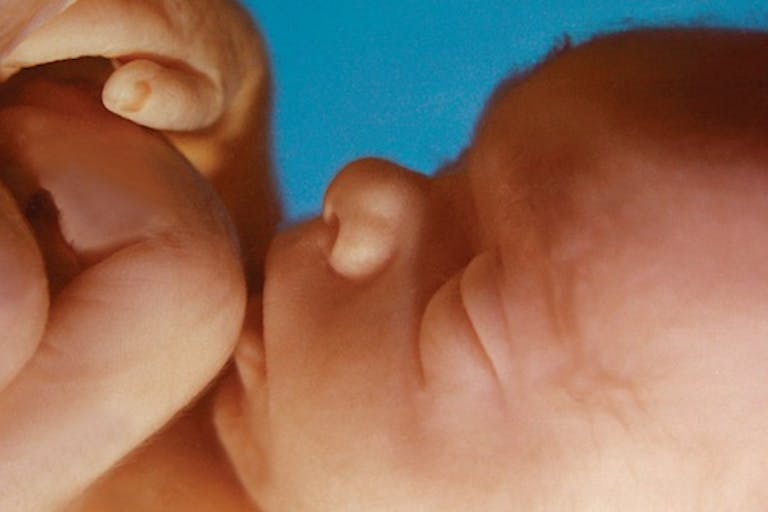
Study: Nearly half of women suffer moderate to high distress after abortion
Michael J. New
·
AMA refuses to retract “demonstrably false” report on fetal pain
(The Daily Signal) The American Medical Association is sticking by its influential report asserting that unborn babies cannot feel pain at 20 weeks, despite subsequent studies finding otherwise. Three of the report’s five authors had or later would have ties to the abortion industry.
The Journal of the American Medical Association defended the report and declined a pro-life research group’s request for a retraction. However, the AMA publication’s top editor recently said the study wasn’t presented as the definitive, final word on the issue of fetal pain.
But despite its being 11 years old, mainstream media outlets such as The New York Times and Los Angeles Times cited the study as authoritative in the recent debate over banning abortions after 20 weeks of pregnancy.
The American Congress of Obstetricians and Gynecologists also has cited the study during the debate over banning late-term abortions.
“The paper’s central argument is demonstrably false,” said James Agresti, president of Just Facts, a fact-checking think tank that focuses on researching and publishing verifiable information about public policy issues.
The authors of the American Medical Association’s 2005 analysis argued that a developing human cannot feel pain until the cerebral cortex is fully formed. The cerebral cortex is the brain’s outermost layer, which produces the ability to think and reason. The AMA report says:
Pain perception requires conscious recognition or awareness of a noxious stimulus. Neither withdrawal reflexes nor hormonal stress responses to invasive procedures prove the existence of fetal pain, because they can be elicited by nonpainful stimuli and occur without conscious cortical processing. … Evidence regarding the capacity for fetal pain is limited but indicates that fetal perception of pain is unlikely before the third trimester.
At least two other studies, one in 2006 by the journal Pain: Clinical Updates, and one in 2012 by researchers at the department of anesthesiology at the University Hospitals Gasthuisberg in Belgium, concluded the opposite, determining the development of a cortex is not necessary for an unborn baby to feel pain.
Nevertheless, in a June 14 letter, Howard Bauchner, editor in chief of the Journal of the American Medical Association, told Agresti that after a review the publication’s editors decided not to retract the 2005 article on the study.
The authors, Bauchner argued, “have included modifiers that reflect their review of the evidence available at the time, including uncertainty.” He added: “Although subsequently published reports may add to existing evidence on a topic, or propose alternative theories, that new information does not require retraction of previous review articles.”
At least three of the five authors were involved or continue to be involved in the abortion industry:
Before the study, Susan J. Lee was a lawyer for the National Abortion and Reproductive Rights Action League, now called NARAL Pro-Choice America, as USA Today and other media outlets reported. Lee left law to enter medical school at the University of California, San Francisco, and was a student there at the time of the study. She currently is a member of the university’s faculty.
Dr. Eleanor Drey is the medical director of the Women’s Options Center of San Francisco General Hospital, which performs abortions, according to the University of California, San Francisco.
Dr. Mark Rosen, a professor of clinical anesthesia and obstetrics at University of California, San Francisco, was a consultant for the Center for Reproductive Rights, the National Abortion Federation, and Planned Parenthood Federation of America, according to his résumé.
The Daily Signal emailed the three authors, but did not receive responses. The report’s two other authors, Dr. Henry J. Peter Ralston and Dr. John Colin Partridge, do not appear to have direct ties to the abortion industry.
Article continues below
Dear Reader,
In 2026, Live Action is heading straight where the battle is fiercest: college campuses.
We have a bold initiative to establish 100 Live Action campus chapters within the next year, and your partnership will make it a success!
Your support today will help train and equip young leaders, bring Live Action’s educational content into academic environments, host on-campus events and debates, and empower students to challenge the pro-abortion status quo with truth and compassion.
Invest in pro-life grassroots outreach and cultural formation with your TRIPLED year-end gift!
In regard to bias, Bauchner wrote to Agresti, “the information we have indicated that authors complied with the [Journal of the American Medical Association’s] conflict of interest requirements in 2005.”
Jim Michalski, a spokesman for the publication, told The Daily Signal that editors would have no additional comment beyond the letter.
Agresti said Bauchner did not address some of his main arguments in favor of the retraction.
“Based on his last email to me, they consider the matter closed,” Agresti said. “I don’t think we will see more action until we can bring enough attention to this.”
David Prentice, vice president and research director for the Charlotte Lozier Institute, a pro-life scientific research organization, also advocated a retraction. He said he doesn’t necessarily believe the American Medical Association is biased.
“For the editors, they may not see the bias among the authors as serious enough,” Prentice said. “Eleven years have passed. The interpretation of the science is old. They may feel the paper is passé and has been supplanted by modern science.”
The 2012 Belgium study said:
Whether a fetus is capable of experiencing pain as a conscious and emotional feeling remains unclear and is subject to great debate, but we cannot deny that the fetal nervous system mounts protective responses to tissue injury. A physiological fetal reaction to painful stimuli occurs from between 16 and 24 weeks’ gestation on. … Evidence is increasing that from the second trimester onwards, the fetus reacts to painful stimuli and that these painful interventions may cause long-term effects.
The 2006 article in Pain asserted:
Multiple lines of evidence thus corroborate that the key mechanisms of consciousness or conscious sensory perception are not dependent on cortical activity. Consistent with this evidence, the responses to noxious stimulation of children with hydranencephaly are purposeful, coordinated, and similar to those of intact children. Further, preterm neonates or adolescents with cortical parenchymal injury mount bio-behavioral responses to pain that are indistinguishable from those of normal controls. Whether consciousness is required for sensory perception has also been questioned by recent studies of adult patients in a persistent vegetative state.
Prentice said he believes the real reason for a retraction by the Journal of the American Medical Association is the conflict of interest, but also sees the interpretation of the science as severely flawed.
“Some people are born without a cortex, but they are able to feel pain and are aware of what is around them,” Prentice said. “Other creatures, birds and some mammals, don’t have a cortex. Would we say they can’t feel pain? Of course not. It’s a scientifically untenable argument.”
Live Action News is pro-life news and commentary from a pro-life perspective.
Contact editor@liveaction.org for questions, corrections, or if you are seeking permission to reprint any Live Action News content.
Guest Articles: To submit a guest article to Live Action News, email editor@liveaction.org with an attached Word document of 800-1000 words. Please also attach any photos relevant to your submission if applicable. If your submission is accepted for publication, you will be notified within three weeks. Guest articles are not compensated (see our Open License Agreement). Thank you for your interest in Live Action News!

Michael J. New
·
Issues
Michael J. New
·
Issues
Right to Life UK
·
Politics
Tabitha Goodling
·
Human Interest
Andrea Trudden
·
Politics
Stefano Gennarini, J.D. and Kelly Heilman, J.D.
·
Guest Column
Fred Lucas
·
Guest Column
Fred Lucas
·
Guest Column
Fred Lucas
·
Guest Column
Fred Lucas
·